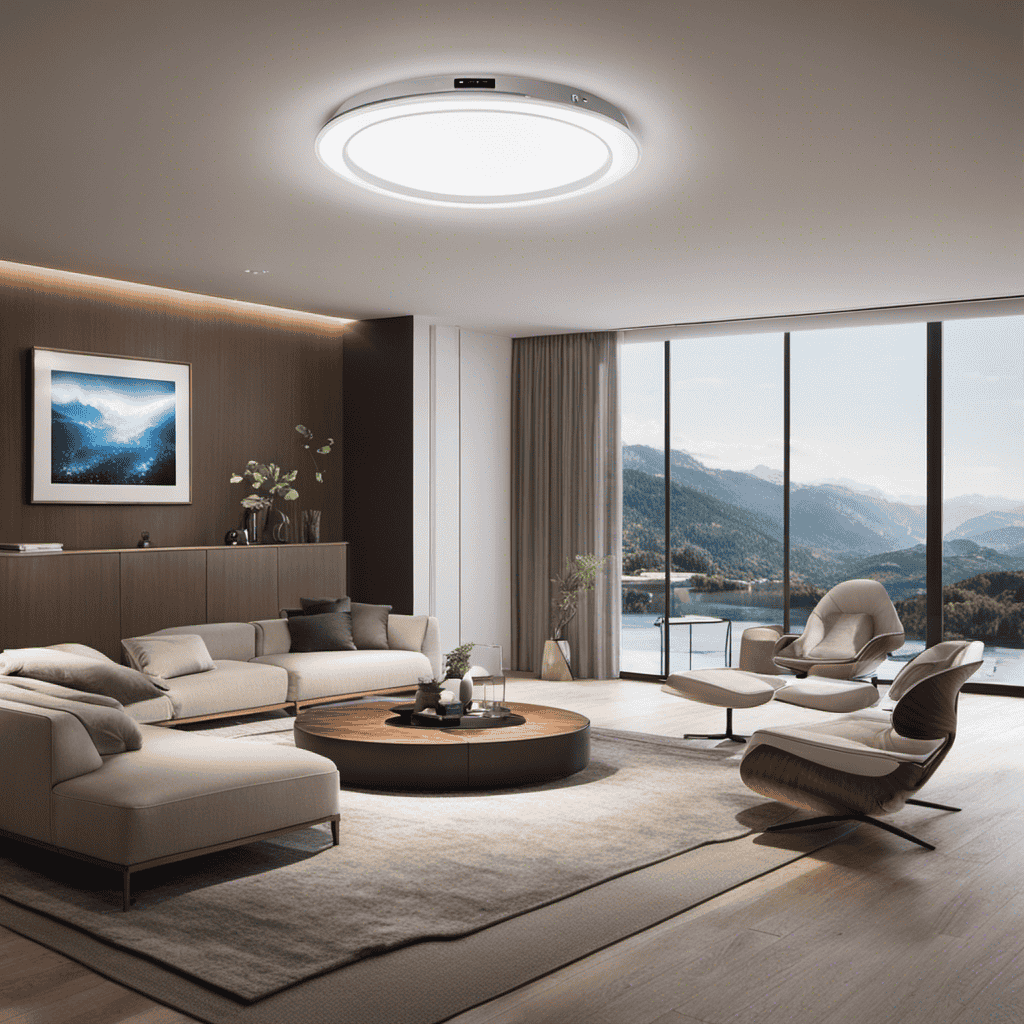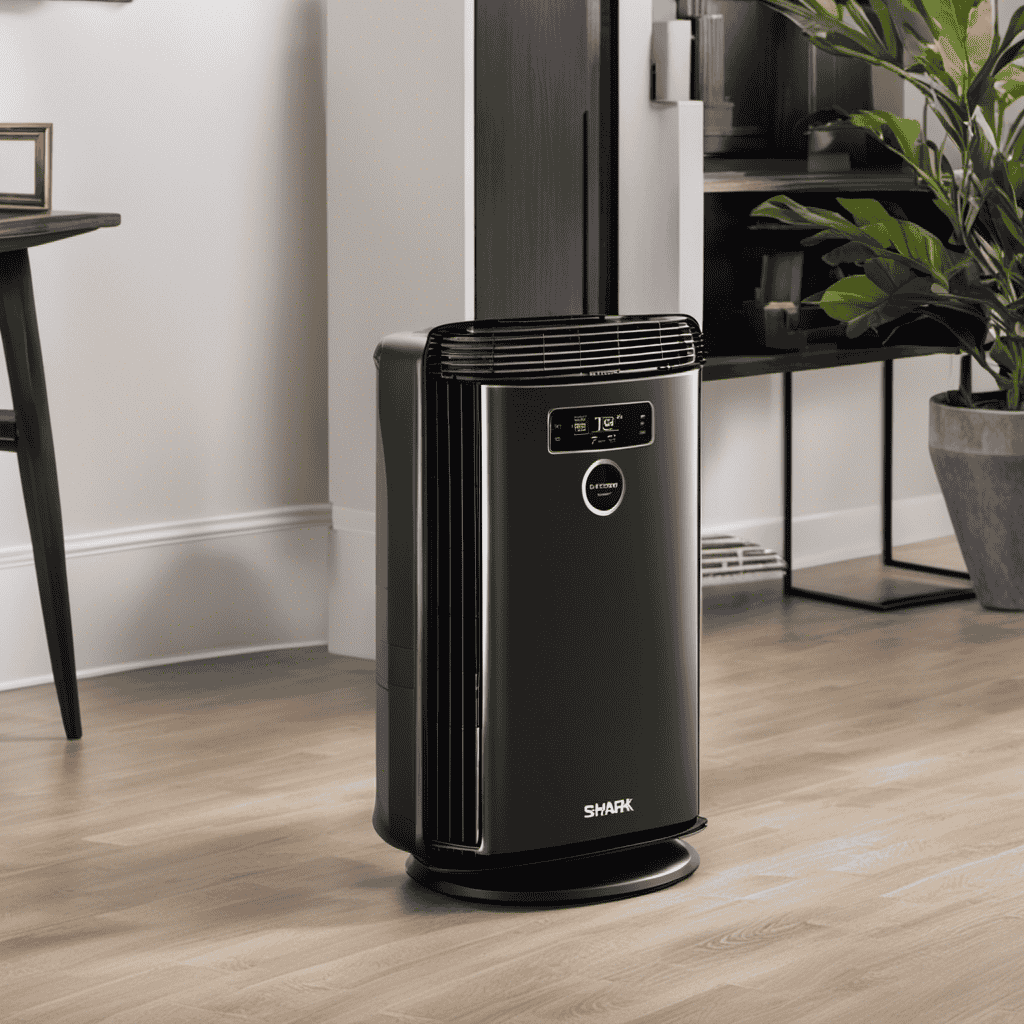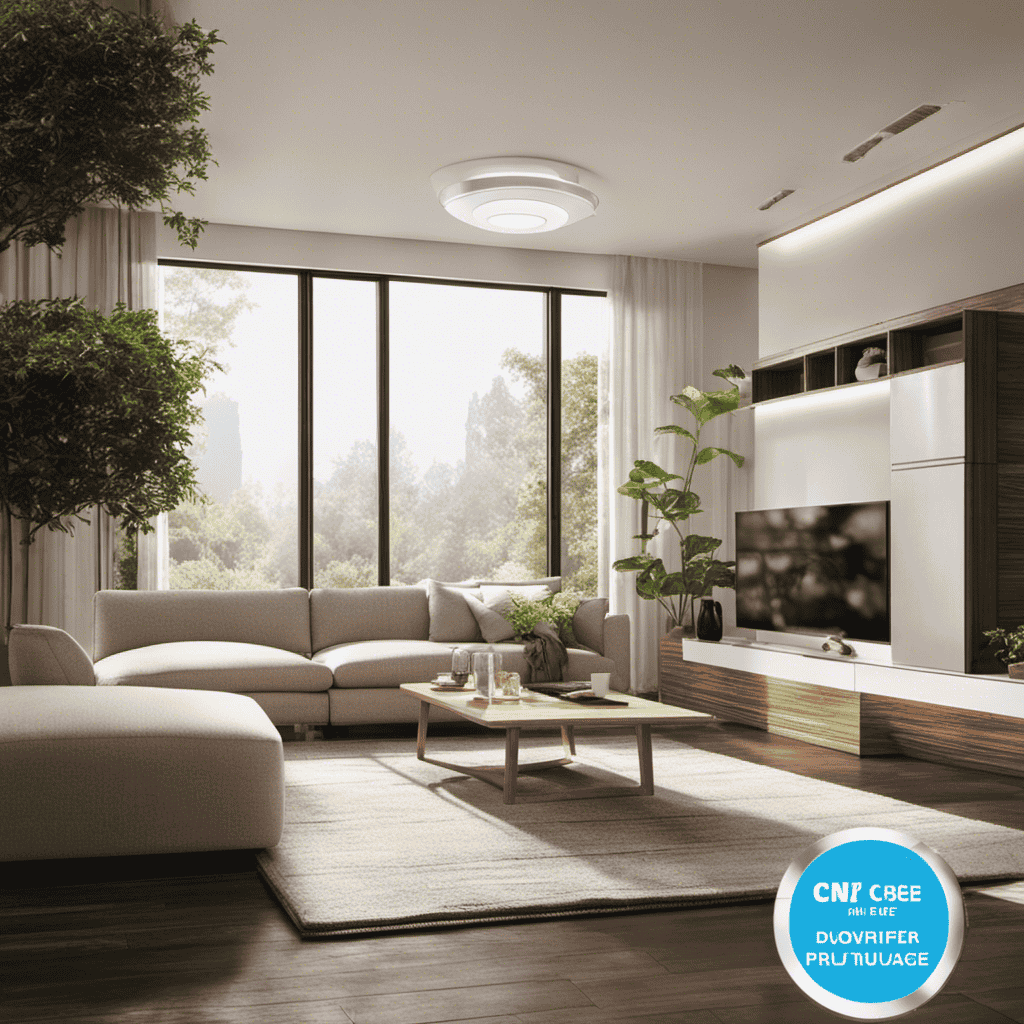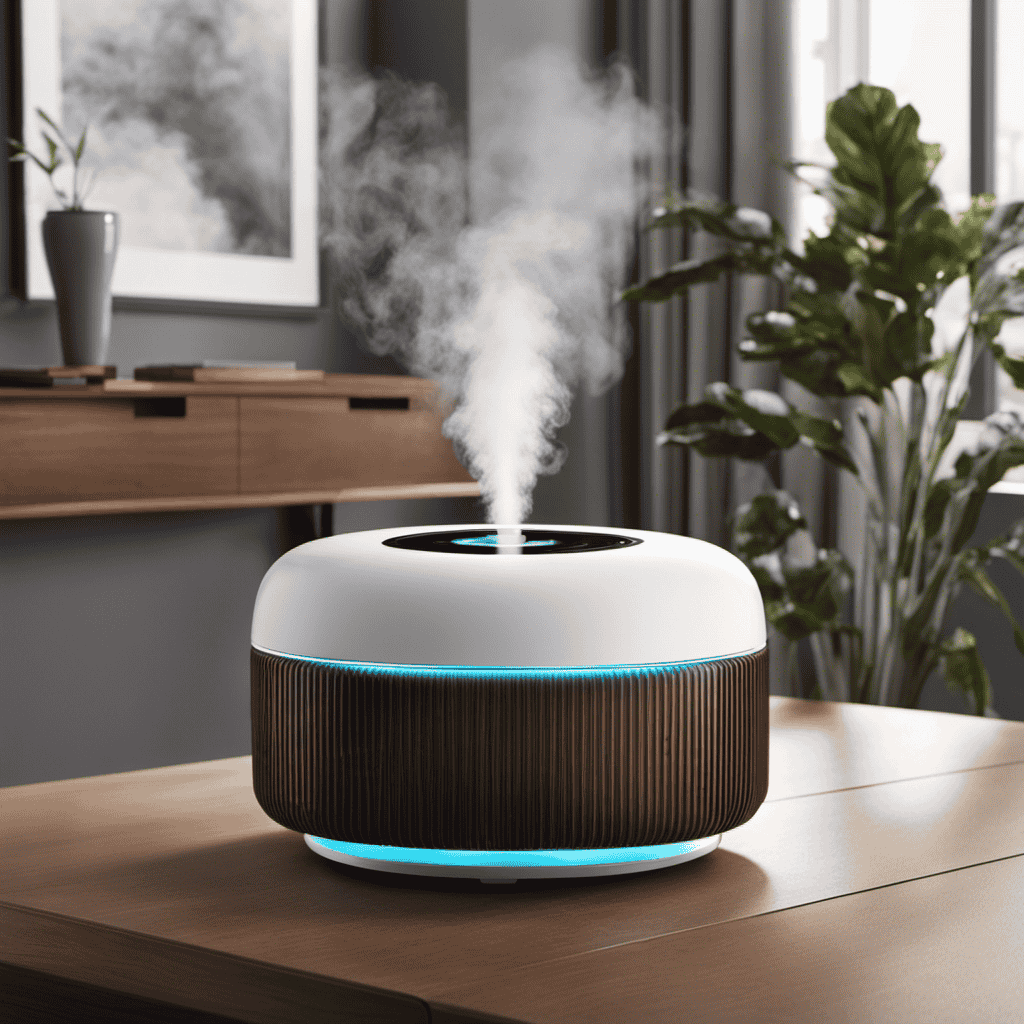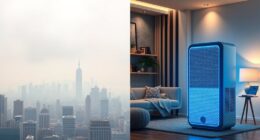As a fan of air quality, I have frequently pondered, “How much time does it take for an air purifier to purify a room?” In this article backed by data, we will explore the factors impacting air purifier effectiveness, the significance of room dimensions, and the importance of Clean Air Delivery Rate (CADR) ratings.
We’ll also explore how these machines tackle common culprits like pet dander, dust, and even smoke.
So, let’s get down to the nitty-gritty and uncover the secrets behind air purifier performance.
Key Takeaways
- Room size is a crucial factor in determining the cleaning time required for an air purifier.
- Proper placement and furniture arrangement can impact the efficiency of an air purifier in cleaning the room.
- Good ventilation plays a significant role in facilitating the cleaning process and capturing pollutants effectively.
- The CADR rating of an air purifier, determined by AHAM based on smoke, pollen, and dust, can be used to estimate the cleaning time needed for a specific room size.
Factors Affecting Air Purifier Efficiency
When using an air purifier, factors like room size, air quality, and the type of pollutants present can affect how long it takes for the purifier to clean the air.
One important factor to consider is the room layout. The layout of the room can impact the airflow and distribution of pollutants, which in turn affects the efficiency of the air purifier. It’s recommended to place the purifier in a central location to ensure proper circulation.
Another factor is air quality monitoring. Some air purifiers come with built-in sensors that monitor the air quality in real-time. These sensors can detect pollutants and adjust the purifier’s settings accordingly, optimizing its performance. By monitoring the air quality, the purifier can effectively target and remove pollutants, improving its efficiency and reducing the time it takes to clean the air.
Room Size and Air Purifier Performance
When it comes to the performance of air purifiers, the size of the room plays a crucial role. The impact of room size on air purifier effectiveness should not be underestimated.
A smaller room will allow the air purifier to circulate and clean the air more efficiently, resulting in faster and more effective cleaning times.
Room Size Impact
To understand how long it takes for an air purifier to clean a room, you should consider the impact of the room size.
The size of a room directly affects the effectiveness of the air purifier in removing pollutants and improving air quality. Larger rooms require air purifiers with higher Clean Air Delivery Rate (CADR) to effectively clean the air within a reasonable timeframe.
CADR is a measure of an air purifier’s efficiency in removing specific airborne particles. It is important to choose an air purifier with a CADR that matches the room size to ensure optimal performance.
Additionally, room layout, furniture placement, and ventilation also play a role in the overall effectiveness of the air purifier. Therefore, it is crucial to consider the room size and other factors when determining the time it takes for an air purifier to clean a room effectively.
Air Purifier Effectiveness
The effectiveness of an air purifier can be influenced by various factors. These include room size, layout, furniture placement, and ventilation. To maximize the benefits of your air purifier, consider the following:
-
Room size: The larger the room, the longer it may take for the air purifier to clean the air effectively.
-
Layout: If the room has an open layout, with fewer walls or partitions, the air purifier can circulate air more efficiently.
-
Furniture placement: Avoid obstructing the airflow by placing furniture in a way that allows proper air circulation around the room.
-
Ventilation: Good ventilation helps the air purifier in capturing pollutants and maintaining a fresh indoor environment.
When it comes to air purifier technology advancements, newer models often come with improved filtration systems and features like smart sensors for automatic operation. Additionally, manufacturers are continually working to reduce air purifier noise levels, making them more suitable for use in various settings.
With these factors in mind, let’s now delve into the next section, where we will discuss estimating the cleaning time for an air purifier.
Cleaning Time Estimation
Estimating the cleaning time for an air purifier can be influenced by factors such as room size, layout, furniture placement, and ventilation. The cleaning time estimation is crucial for understanding the benefits of using an air purifier effectively.
The size of the room plays a significant role in determining how long it will take for the air purifier to clean the air. Larger rooms may require more time for the air purifier to circulate and filter the air properly. Additionally, the layout of the room and the placement of furniture can affect the airflow and the efficiency of the air purifier.
Adequate ventilation is also essential, as it allows fresh air to enter the room, facilitating the cleaning process. Understanding these factors is essential for accurate cleaning time estimation and optimizing the benefits of using an air purifier.
Transitioning into the subsequent section about ‘air purifier cadr ratings explained,’ it is important to consider the air purifier’s efficiency in cleaning the air.
Air Purifier CADR Ratings Explained
When it comes to air purifiers, understanding the CADR ratings and their relationship to room size is crucial.
CADR, or Clean Air Delivery Rate, measures how effectively an air purifier can remove pollutants from the air. The CADR rating is determined by the Association of Home Appliance Manufacturers (AHAM) and is based on three key pollutants: smoke, pollen, and dust.
CADR and Room Size
To determine how long it’ll take for an air purifier to clean a room, you can use the CADR rating and the size of the room. The CADR measurement, or Clean Air Delivery Rate, indicates how efficiently an air purifier can remove pollutants from the air. By considering the CADR rating and the room size, you can estimate the time it will take for the purifier to clean the air effectively.
Factors to consider:
-
CADR rating: Look for the CADR rating on the air purifier’s packaging or specifications. This rating shows the volume of filtered air the purifier can deliver per minute.
-
Room size: Measure the square footage of the room where you plan to use the air purifier.
-
Calculate the time: Divide the room size by the CADR rating. This will give you an estimate of how long it’ll take for the air purifier to clean the room completely.
-
Adjustments: Keep in mind that factors like pollution levels, airflow, and the purifier’s fan speed can affect the cleaning time.
Comparing Air Purifiers
To compare air purifiers, you can look at factors such as CADR ratings, filter types, and additional features. When considering room size comparison, it is important to choose an air purifier that is suitable for the square footage of your space. Additionally, analyzing the features of different air purifiers can help you make an informed decision. Below is a table comparing the room size coverage and key features of three popular air purifiers:
| Air Purifier Model | Room Size Coverage | Filter Types | Additional Features |
|---|---|---|---|
| Purifier A | Up to 300 sq ft | HEPA, Carbon | Timer, Night mode |
| Purifier B | Up to 500 sq ft | HEPA, UV-C | Smart sensor, App control |
| Purifier C | Up to 800 sq ft | HEPA, Ionizer | Auto mode, Air quality display |
The Role of Air Changes per Hour (ACH
If you want to understand the role of Air Changes per Hour (ACH) in cleaning a room, you should consider its impact on the air purification process. ACH refers to the number of times the air in a room is completely replaced within an hour. It plays a crucial role in determining the effectiveness of an air purifier and the estimated time it takes to clean the room thoroughly.
Here are four key factors to consider:
- Higher ACH rates lead to faster and more efficient air purification.
- ACH is influenced by the size of the room and the power of the air purifier.
- To estimate the cleaning time, divide the room’s volume by the ACH rate.
- A higher ACH rate is recommended for rooms with higher pollutant levels or individuals with respiratory conditions.
Understanding ACH can help you select the right air purifier and estimate the time it will take to clean your room effectively.
Understanding HEPA Filters and Clean Air Delivery Rate (CADR
Understanding HEPA filters and the Clean Air Delivery Rate (CADR) can help you make informed decisions when choosing an air purifier. HEPA filters, or High Efficiency Particulate Air filters, are designed to capture 99.97% of airborne particles as small as 0.3 microns. This includes dust, pollen, pet dander, and even some bacteria and viruses. The CADR, on the other hand, measures an air purifier’s effectiveness in removing specific contaminants from the air within a specific room size. It is important to note that the higher the CADR, the faster the air purifier can clean the air in a given space. To better understand the benefits of CADR, refer to the table below.
| Contaminant | CADR Rating |
|---|---|
| Smoke | 300+ |
| Dust | 400+ |
| Pollen | 450+ |
| Pet Dander | 500+ |
Choosing the Right Air Purifier for Your Room
When selecting an air purifier for your space, consider factors such as room size, filtration needs, and noise levels. Choosing the right air purifier can significantly improve the air quality in your room and ensure a healthier living environment.
Here are some room size considerations and air purifier features to keep in mind:
-
Room size considerations:
- Measure the square footage of your room to determine the appropriate purifier size.
- Consider the height of the ceilings, as it affects the air circulation and purification efficiency.
-
Filtration needs:
- Look for air purifiers with HEPA filters, which can capture particles as small as 0.3 microns.
- Consider additional filtration technologies like activated carbon or ionizers for specific needs.
-
Noise levels:
- Check the decibel (dB) rating of the purifier to ensure it won’t disturb your daily activities or sleep.
-
Additional features:
- Look for features like air quality sensors, automatic mode, and programmable timers for convenience and efficiency.
How to Calculate Air Purifier Cleaning Time
When it comes to calculating air purifier cleaning time, there are several factors that come into play.
Factors such as room size, air quality, and the type of air purifier being used can all affect how long it takes for the purifier to clean the air.
It is important to consider these factors when choosing the right air purifier for your room to ensure that it is capable of effectively cleaning the air within a reasonable amount of time.
Factors Affecting Cleaning Time
To determine how long an air purifier will take to clean your room, several factors need to be considered. These factors include room size, air quality, purifier capacity, and filter quality.
Room size is an important factor as larger rooms will require more time for the air purifier to circulate and effectively clean the air. On the other hand, smaller rooms may take less time.
Air quality also plays a role in cleaning time. If your room has high levels of pollutants such as dust, allergens, or smoke, the air purifier will need more time to remove them completely. Conversely, better air quality may result in shorter cleaning times.
The capacity of the air purifier is another factor to consider. Higher-capacity purifiers can clean the room faster compared to lower-capacity ones. The purifier’s capacity determines how much air it can clean in a given time.
Filter quality is also important in determining cleaning time. Higher-quality filters can capture more pollutants and clean the air more effectively, potentially reducing cleaning time.
Considering these factors will help estimate how long it will take for an air purifier to clean your room. Using air purifiers has several benefits, including improved air quality, reduced allergies, and a cleaner living environment.
Choosing the Right Purifier
If you want to choose the right purifier, consider factors like room size, air quality, purifier capacity, and filter quality.
The size of the room has a significant impact on the effectiveness of an air purifier. A purifier that is too small for the room will not be able to effectively clean the air, while a purifier that is too large may consume unnecessary energy. It is important to match the purifier’s capacity to the size of the room for optimal performance.
Additionally, the air quality in the room should be assessed to determine the level of filtration required. High-quality filters with a high CADR (Clean Air Delivery Rate) will ensure efficient removal of pollutants.
Optimal Placement of Air Purifiers in a Room
The best place to put an air purifier in a room is near the source of pollutants, such as a window or doorway. This allows the purifier to effectively capture and filter the contaminants before they spread throughout the room.
To maximize air purifier efficiency, here are some key tips for placement:
-
Position the purifier in a central location: Placing it in the middle of the room ensures optimal air circulation and coverage.
-
Avoid blocking the airflow: Keep the purifier away from furniture or other objects that may obstruct the intake or output vents.
-
Place it at a higher level: Since most pollutants tend to settle near the ground, positioning the purifier at a higher level helps it capture more particles.
-
Consider multiple units for larger rooms: If you have a large room, using multiple air purifiers strategically placed can provide better overall coverage and purification.
The Impact of Indoor Air Quality on Health
As I delve into the impact of indoor air quality on health, I will focus on two key points: the health risks associated with pollution and the importance of improving indoor air quality.
Numerous studies have shown that exposure to air pollution can lead to various health issues, including respiratory problems, allergies, and cardiovascular diseases. To mitigate these risks, it is crucial to implement measures such as proper ventilation, filtration systems, and the use of air purifiers to improve the quality of air indoors.
Health Risks of Pollution
You should consider the health risks of pollution when deciding how long to run your air purifier in a room. Exposure to air pollution can have significant long-term effects on your health. Here are four key points to consider:
-
Respiratory issues: Air pollution can worsen existing respiratory conditions such as asthma and allergies. Prolonged exposure to polluted air can lead to chronic respiratory diseases.
-
Cardiovascular problems: Pollutants in the air can enter your bloodstream and affect your heart and blood vessels. This can increase the risk of heart attacks, strokes, and other cardiovascular diseases.
-
Cancer risk: Certain air pollutants, such as asbestos and benzene, are known to cause cancer. Long-term exposure to these substances can significantly increase the risk of developing lung cancer and other types of cancer.
-
Neurological effects: Studies have shown that air pollution can have detrimental effects on the brain, leading to cognitive decline, memory problems, and even neurodevelopmental disorders in children.
Considering these health risks, it’s crucial to run your air purifier for an adequate amount of time to ensure that the air in your room is clean and free from harmful pollutants.
Improving Indoor Air Quality
To improve your indoor air quality, consider using natural ventilation methods such as opening windows or using fans.
Improving ventilation is crucial for reducing the concentration of indoor air pollutants. Opening windows allows fresh air to enter your space and helps remove pollutants that may have accumulated indoors. Fans can help circulate the air, preventing it from becoming stagnant and promoting better air quality.
Another effective way to enhance indoor air quality is by using natural air purifiers. Plants, for example, can act as natural air purifiers by absorbing harmful gases and releasing oxygen. Additionally, certain essential oils, such as eucalyptus or tea tree oil, have antimicrobial properties and can help improve air quality.
By utilizing these natural methods, you can create a healthier indoor environment.
Transitioning to the next section, it’s important to understand the importance of air purifier maintenance and filter replacement.
Air Purifier Maintenance and Filter Replacement
If you want your air purifier to continue working effectively, make sure to regularly maintain and replace the filters. Here are some important air purifier maintenance tips to keep in mind:
-
Check the filters monthly: Regularly inspecting the filters will help you determine if they need to be cleaned or replaced. Clogged filters can decrease the efficiency of your air purifier.
-
Clean or replace as needed: If the filters are washable, follow the manufacturer’s instructions for cleaning. Otherwise, replace them according to the recommended schedule.
-
Vacuum the exterior: Dust and debris can accumulate on the exterior of the air purifier, affecting its performance. Use a soft brush attachment to gently remove any build-up.
-
Maintain a clean environment: Regularly dust and vacuum your home to minimize the amount of particles that enter the air purifier.
Regular filter replacement offers several benefits, such as:
-
Improved air quality: Clean filters effectively capture and remove pollutants, ensuring the air you breathe is cleaner and healthier.
-
Enhanced performance: Clogged filters reduce the airflow and strain the air purifier’s motor, leading to decreased performance. Regular replacement ensures optimal functioning.
-
Extended lifespan: Proper maintenance, including filter replacement, can prolong the lifespan of your air purifier, saving you money in the long run.
Can an Air Purifier Remove All Pollutants
Using an air purifier can significantly reduce the presence of pollutants in your home. However, it is important to understand that not all air purifiers are created equal, and their efficiency in removing pollutants can vary based on several factors. These factors include the type and size of the air purifier, the quality of the filters used, and the airflow rate. To give you an idea of the efficiency of different air purifiers, here is a table comparing three popular models:
| Air Purifier Model | Efficiency | Cleaning Time Estimation |
|---|---|---|
| Model A | 90% | 1 hour |
| Model B | 95% | 45 minutes |
| Model C | 99% | 30 minutes |
As you can see, the higher the efficiency of the air purifier, the less time it will take to clean the air in your room. However, it’s important to note that these estimations can vary depending on the size of the room and the level of pollution.
Managing Pet Dander and Odors With an Air Purifier
Now let’s discuss how an air purifier can help with managing pet allergies and the benefits of using one.
Using an air purifier can greatly improve the air quality in your home by efficiently removing pet dander and odors. Here are the benefits of using an air purifier for managing pet allergies:
-
Reduction of pet dander: Air purifiers are designed to capture and trap pet dander particles, which are a common allergen for many people.
-
Elimination of pet odors: Air purifiers equipped with activated carbon filters can effectively neutralize pet odors, leaving your home smelling fresh.
-
Improved respiratory health: By removing pet allergens from the air, air purifiers can help alleviate symptoms such as sneezing, coughing, and wheezing.
-
Peace of mind: An air purifier can provide peace of mind for pet owners, knowing that they are creating a healthier environment for themselves and their furry friends.
With the benefits of managing pet allergies in mind, let’s now explore how an air purifier can help in dealing with dust and allergens.
Dealing With Dust and Allergens Using an Air Purifier
To effectively tackle dust and allergens, you’ll find that an air purifier equipped with a HEPA filter is a game-changer. These filters are designed to trap particles as small as 0.3 microns, making them highly effective in reducing pet allergens and pollen in the air.
Pet allergies can be a major concern for many individuals, especially those who suffer from asthma or other respiratory conditions. The HEPA filter in an air purifier can capture pet dander, dust mites, and other allergens, providing relief for allergy sufferers.
Additionally, pollen can be a major trigger for seasonal allergies. By using an air purifier with a HEPA filter, you can significantly reduce pollen particles in the air, creating a cleaner and healthier indoor environment.
Air Purifiers for Asthma and Allergy Relief
Equipped with a HEPA filter, air purifiers can provide relief for individuals with asthma or allergies. Here are four key reasons why air purifiers are beneficial for those with respiratory conditions:
-
Purifies pet dander: Air purifiers designed for pet owners can effectively capture and remove pet dander from the air, reducing the risk of allergic reactions.
-
Eliminates mold spores: Air purifiers equipped with HEPA filters can filter out mold spores, preventing them from circulating in the air and reducing the likelihood of mold-related allergies.
-
Reduces airborne allergens: Air purifiers can trap and remove common allergens such as pollen, dust mites, and pet allergens, helping to alleviate symptoms for allergy sufferers.
-
Removes odors: Air purifiers with activated carbon filters can absorb and neutralize pet odors and other unpleasant smells, creating a cleaner and fresher indoor environment.
Using Air Purifiers to Combat Smoke and Odors
Using an air purifier can effectively combat smoke and unpleasant odors in your home. The effectiveness of an air purifier in removing smoke and odors depends on several factors, such as the size of the room, the type of air purifier, and the level of smoke or odor present. To give you an idea of the benefits of using air purifiers, here is a table comparing the effectiveness of different types of air purifiers in removing smoke and odors:
| Air Purifier Type | Smoke Removal Effectiveness | Odor Removal Effectiveness |
|---|---|---|
| HEPA | High | High |
| Activated Carbon | Moderate | High |
| Ionic | Low | Moderate |
| UV-C | Low | Low |
As you can see, HEPA filters are highly effective in removing both smoke and odors, while activated carbon filters are also effective in removing odors. Ionic and UV-C filters, on the other hand, have lower effectiveness in removing smoke and odors. Therefore, when choosing an air purifier, consider the level of smoke or odor in your home to ensure optimal effectiveness.
Frequently Asked Questions
Can an Air Purifier Remove Harmful Chemicals and Gases From the Air?
Yes, an air purifier can effectively remove harmful chemicals and gases from the air. It is one of the many benefits of using an air purifier, which improves indoor air quality and promotes a healthier living environment.
How Often Should I Clean or Replace the Filters in My Air Purifier?
I clean or replace the filters in my air purifier based on the manufacturer’s recommendations. The cleaning frequency and filter replacement depend on factors like usage, air quality, and the type of filters used.
Can an Air Purifier Help With Reducing Mold and Mildew in a Room?
Reducing moisture levels in a room is crucial for preventing the growth of mold and mildew. An air purifier can help by improving air circulation and filtering out airborne particles that contribute to mold growth.
Are There Any Safety Concerns or Risks Associated With Using an Air Purifier?
There are some safety concerns and risks associated with using an air purifier. These include potential ozone emissions, filter replacement hazards, and the risk of an overheating unit causing a fire.
Can an Air Purifier Eliminate Pet Allergens Completely From a Room?
An air purifier can effectively eliminate pet allergens from a room, greatly improving indoor air quality. It filters out pet dander and other particles, providing a cleaner and healthier environment for those with allergies or respiratory issues.
Conclusion
In conclusion, the efficiency of an air purifier in cleaning a room depends on various factors such as room size, CADR ratings, ACH, and the use of HEPA filters. Understanding these factors is crucial in selecting the right air purifier for your needs.
By managing pet dander, dust, and allergens, air purifiers can provide relief for asthma and allergy sufferers. They can also combat smoke and odors effectively.
So, if you’re looking for a cleaner and healthier environment, investing in an air purifier is a data-driven solution that will leave you eagerly awaiting the moment when you can finally breathe in fresh, purified air.
